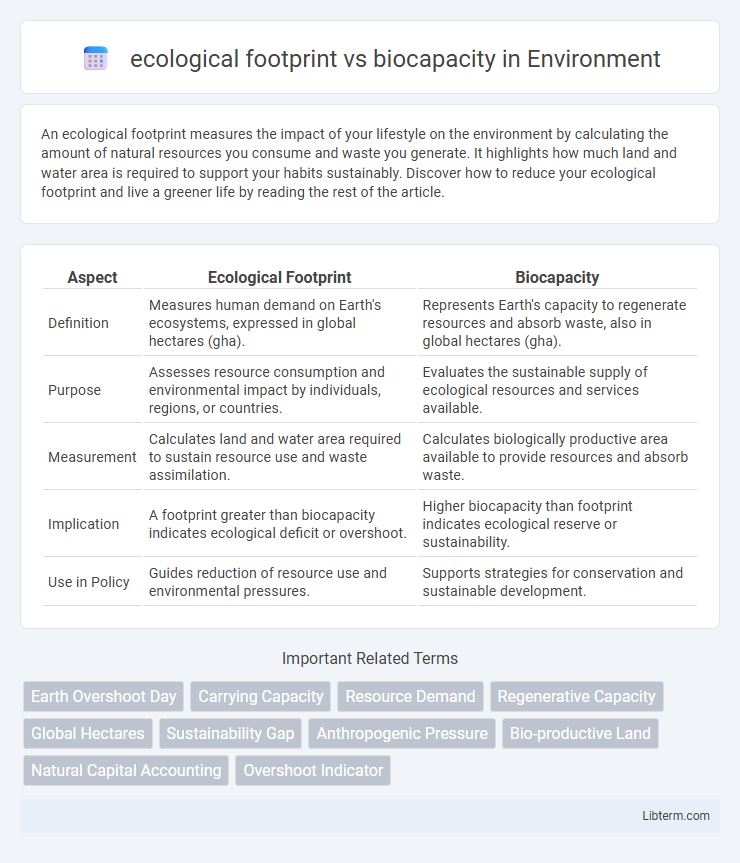An ecological footprint measures the impact of your lifestyle on the environment by calculating the amount of natural resources you consume and waste you generate. It highlights how much land and water area is required to support your habits sustainably. Discover how to reduce your ecological footprint and live a greener life by reading the rest of the article.
Table of Comparison
| Aspect | Ecological Footprint | Biocapacity |
|---|---|---|
| Definition | Measures human demand on Earth's ecosystems, expressed in global hectares (gha). | Represents Earth's capacity to regenerate resources and absorb waste, also in global hectares (gha). |
| Purpose | Assesses resource consumption and environmental impact by individuals, regions, or countries. | Evaluates the sustainable supply of ecological resources and services available. |
| Measurement | Calculates land and water area required to sustain resource use and waste assimilation. | Calculates biologically productive area available to provide resources and absorb waste. |
| Implication | A footprint greater than biocapacity indicates ecological deficit or overshoot. | Higher biocapacity than footprint indicates ecological reserve or sustainability. |
| Use in Policy | Guides reduction of resource use and environmental pressures. | Supports strategies for conservation and sustainable development. |
Understanding Ecological Footprint
The ecological footprint measures the demand humans place on Earth's ecosystems by quantifying the amount of land and water area required to produce the resources consumed and absorb waste generated. Biocapacity represents the capacity of ecosystems to regenerate these resources and absorb waste, providing a benchmark for sustainability. Understanding the balance between ecological footprint and biocapacity is crucial for evaluating whether a population lives within the means of its environment or depletes natural capital, leading to ecological deficits or overshoot.
Defining Biocapacity
Biocapacity refers to the capacity of ecosystems to produce renewable resources and absorb waste, measured in global hectares. It indicates the amount of biologically productive land and water available to meet human demands. Comparing biocapacity with ecological footprint reveals whether a region operates within its environmental means or faces resource deficits.
Key Differences Between Ecological Footprint and Biocapacity
Ecological footprint measures the total demand humans place on natural resources, expressed in global hectares, while biocapacity represents the supply of these resources that ecosystems can regenerate sustainably within the same unit. The key difference lies in that ecological footprint quantifies consumption and waste generation, whereas biocapacity indicates the environment's ability to absorb those wastes and replenish resources. When ecological footprint exceeds biocapacity, a country or region experiences ecological deficit, leading to resource depletion and environmental degradation.
Measuring Ecological Demand and Supply
Ecological footprint quantifies the total human demand on natural resources by measuring consumption across carbon, cropland, grazing, forest products, fishing grounds, and built-up land, reflecting the ecological assets required for sustaining lifestyles. Biocapacity represents the supply side, denoting the capacity of ecosystems to regenerate resources and absorb waste, calculated by assessing the productive area of forests, croplands, grazing lands, fishing grounds, and built-up areas available per person or population. Comparing ecological footprint and biocapacity reveals sustainability status, with overshoot indicating a deficit where demand exceeds Earth's regenerative capacity, essential for guiding environmental policy and resource management.
Global Trends in Ecological Footprint
Global trends in ecological footprint reveal a significant imbalance as humanity's demand on nature exceeds Earth's biocapacity by approximately 75%, leading to ecological overshoot. Increasing consumption patterns, population growth, and rising carbon emissions contribute to the growing ecological footprint, while biocapacity remains limited by land degradation, deforestation, and biodiversity loss. Countries with high ecological footprints, such as the United States, China, and India, drive global resource depletion, emphasizing the urgent need for sustainable resource management and reduced carbon footprints worldwide.
Regional Variations in Biocapacity
Regional variations in biocapacity are influenced by differences in land availability, soil fertility, and climate conditions, which affect the ability of ecosystems to regenerate resources and absorb waste. Areas with abundant forests, fertile soils, and favorable climate conditions generally exhibit higher biocapacity, while arid regions, urbanized zones, and areas with intensive agriculture often display lower biocapacity. These disparities directly impact the ecological footprint, with regions exhibiting low biocapacity frequently experiencing ecological deficits and reliance on external resources.
Causes of Ecological Overshoot
Ecological overshoot occurs when a population's ecological footprint exceeds the region's biocapacity, leading to resource depletion and environmental degradation. Primary causes include overconsumption of natural resources, deforestation, fossil fuel dependency, and unsustainable agricultural practices. Urbanization and population growth intensify resource demand, exacerbating the gap between ecological footprint and biocapacity.
The Impact of Population Growth
Population growth intensifies the ecological footprint by increasing demand for resources such as food, water, and energy, often exceeding the Earth's biocapacity to regenerate these resources sustainably. Rapid urbanization and expanding agricultural activities driven by rising populations contribute to habitat loss and increased carbon emissions, further stressing ecological limits. Countries with high population growth rates face greater challenges in balancing their ecological footprint with available biocapacity, leading to resource depletion and environmental degradation.
Strategies to Reduce Ecological Footprint
Implementing renewable energy sources such as solar and wind power significantly reduces the ecological footprint by lowering carbon emissions. Enhancing sustainable agriculture practices, including crop rotation and organic farming, improves biocapacity by preserving soil health and biodiversity. Promoting circular economy principles minimizes waste and optimizes resource use, helping balance ecological footprint with available biocapacity.
Towards a Sustainable Balance
Ecological footprint measures humanity's demand on natural resources, while biocapacity indicates the Earth's ability to regenerate those resources. Striving towards a sustainable balance requires reducing ecological footprints below global biocapacity through efficient resource use and conservation. Achieving this equilibrium ensures long-term environmental health and supports sustainable development goals.
ecological footprint Infographic

 libterm.com
libterm.com